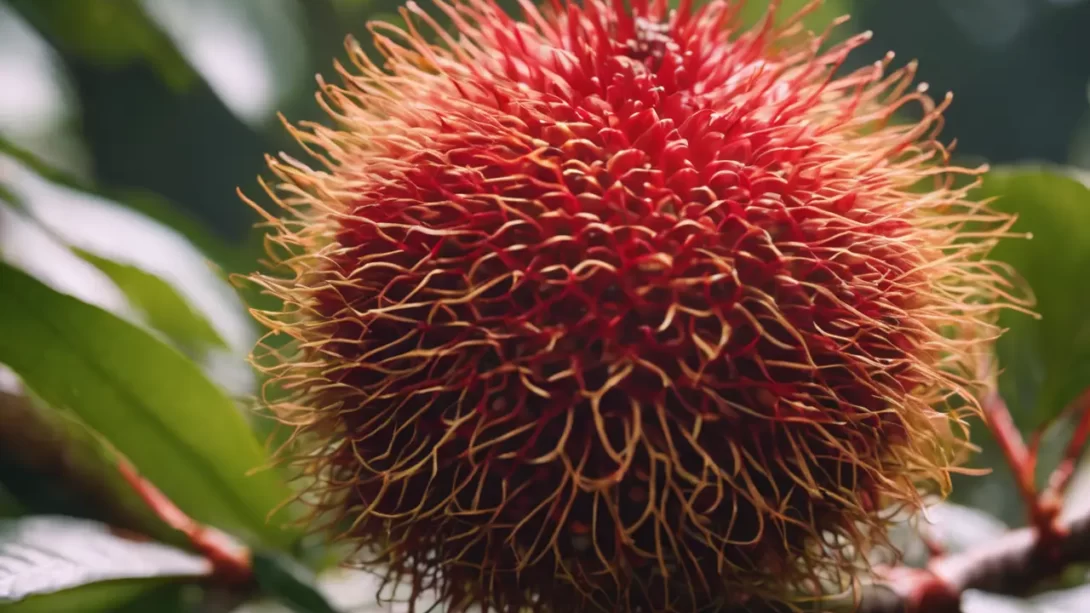Rambutan, Nephelium lappaceum, is a tropical fruit native to Southeast Asia, cherished for its unique appearance and sweet, juicy taste. This exotic fruit, encased in a hairy red shell, is not only a culinary delight but also packed with vitamins and minerals. Growing rambutan can be a rewarding experience for those in suitable climates, offering both nutritional and aesthetic benefits.
Rambutan Trees
Rambutan trees are evergreen trees that can grow up to 20 meters in height. They are known for their dense, lush foliage and can bear fruit twice a year in optimal conditions. There are several varieties of rambutan, each with distinct characteristics in terms of fruit size, sweetness, and tree hardiness. Some popular varieties include ‘Rongrien’, ‘Seematjan’, and ‘Si Chomphu’.
Climatic and Soil Requirements
Rambutan trees thrive in a tropical climate, requiring high humidity and consistent rainfall. They are best suited to temperatures between 22°C to 30°C (72°F to 86°F). These trees do not tolerate cold climates or frost.
The ideal soil for rambutan cultivation is deep, rich loam with good drainage. The soil pH should be slightly acidic to neutral, ranging from 5.5 to 6.5. Proper soil conditions are vital for the healthy growth of the tree and fruit production.
Propagation Methods
Rambutan trees can be propagated either by seed or grafting.
Propagating from Seeds:
- Seed Selection: Use fresh seeds from a ripe rambutan fruit for the best germination rates.
- Preparation: Clean the seeds by removing any adhering fruit flesh, as this can encourage fungal growth.
- Germination: Plant the seeds in a moist, well-draining growing medium. Germination typically occurs within 10 to 21 days.
- Care: Keep the soil consistently moist and provide the seedlings with partial shade until they are strong enough to be transplanted.
Propagation through Grafting:
Grafting involves joining the tissue of one plant (scion) with the root system of another plant (rootstock). This method is often used for commercial cultivation as it ensures the new tree inherits the fruit characteristics of the parent plant.
Planting and Initial Care
When planting a rambutan tree, consider the following:
- Spacing: Rambutan trees require ample space to grow. Plant them at least 10 meters apart from each other and from other structures.
- Planting Depth: The root ball should be placed in a hole that’s as deep as its container and twice as wide.
- Watering: Young rambutan trees need regular watering to establish a strong root system. However, avoid waterlogging as it can harm the plant.
- Mulching and Fertilization: Apply organic mulch around the base of the tree to retain moisture. Use a balanced fertilizer regularly to provide necessary nutrients.
Pruning and Maintenance
Pruning is crucial in the development of a healthy rambutan tree. It promotes better air circulation, sunlight penetration, and can enhance fruit production. Here’s how to approach it:
- Timing: The best time for pruning is after the harvest or before the flowering season.
- Pruning Technique: Remove any dead, diseased, or overcrowded branches. Thin out the canopy to allow light and air to reach the inner branches.
- Ongoing Maintenance: Regularly check for pests like aphids and mealybugs, and manage them promptly. Look out for signs of diseases, such as leaf spots or root rot, and apply appropriate treatments.
Flowering and Pollination
Rambutan trees usually start flowering 5 to 6 years after planting. The flowering process is as follows:
- Flower Development: The tree produces small, greenish-white flowers, which are typically either male or female.
- Pollination: Rambutan trees are often cross-pollinated by bees and other insects. In some cases, hand pollination may be necessary to ensure a good fruit set, especially in areas with fewer natural pollinators.
Fruit Development and Harvesting
The period from flowering to fruit maturity is crucial. Here’s what to look for and how to harvest:
- Fruit Maturity: Rambutan fruits typically mature around 15-18 weeks after flowering. The skin turns from green to a bright red or yellow, depending on the variety, and the spiky “hairs” on the fruit become more pronounced.
- Harvesting Technique: Use a sharp knife or secateurs to cut the fruit clusters from the branches. Be gentle to avoid damaging the tree and the remaining fruits.
- Harvest Time: It’s best to harvest in the morning when the temperatures are cooler, to retain the fruit’s freshness.
During the fruit development stage, continue to monitor the health of the tree. Regular watering is essential, but over-watering should be avoided as it can lead to root rot. Providing balanced nutrition during this phase is also important for the development of healthy, succulent fruits.
Post-Harvest Handling and Storage
After harvesting, proper handling and storage are key to preserving the quality of rambutan fruits. Follow these guidelines:
- Handling: Handle the fruits gently to prevent bruising. Rambutans are delicate and can be damaged easily.
- Cleaning: Gently wash the fruits to remove any dirt or residues.
- Storage: Store rambutan fruits at a temperature of about 10-12°C (50-54°F) with good humidity. Under these conditions, they can last for up to a couple of weeks. Refrigeration can extend their shelf life, but avoid freezing as it damages the fruit.
Common Challenges and Solutions
Growing rambutan trees can be challenging, especially in non-tropical climates. Some common issues include:
- Climate Limitations: Rambutan trees require a tropical climate and do not tolerate frost. In cooler regions, they can be grown in greenhouses where temperature and humidity are controlled.
- Pests and Diseases: Regular inspections can help in early detection and control of pests and diseases. Organic pesticides and fungicides can be effective, but proper application is crucial to avoid harming the tree.
Conclusion
Growing rambutan requires patience and attention, especially in maintaining the right climatic conditions and caring for the trees. Despite the challenges, cultivating these exotic fruits can be highly rewarding. Not only do they provide a delicious and nutritious harvest, but they also add a tropical aesthetic to your garden. Whether you’re a seasoned fruit grower or a hobbyist looking to try something new, growing rambutan offers a unique and satisfying gardening experience. Remember, the key to success lies in understanding the specific needs of the rambutan tree and providing consistent care throughout its growth cycle.



